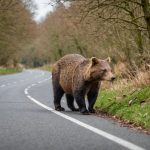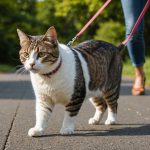How UK Traffic Regulations Help Mitigate Roadkill Among Native Wildlife
The UK, with its diverse and rich wildlife, faces a significant challenge in protecting its native species from the dangers posed by road traffic. Roadkill, or the killing of animals by vehicles, is a pervasive issue that affects various species, from the iconic deer to the lesser-known badger. In this article, we will delve into the measures and regulations implemented in the UK to mitigate roadkill, and how these efforts are making a difference.
Understanding the Roadkill Risk
Roadkill is not just a tragic event; it also has broader ecological implications. It can lead to population decline, genetic isolation, and even local extinctions. For instance, in Australia, a “roadkill hotspot” has been identified where over 150 endangered koalas die annually due to vehicle collisions[2].
A découvrir également : Exploring the UK”s Contribution to Global Initiatives for the Conservation of Migratory Shark Species
In the UK, the risk of roadkill varies across different areas. Urban and rural areas present different challenges:
Urban Areas
In urban areas, the density of roads and traffic is higher, increasing the risk of wildlife vehicle collisions. Here, smaller species like hedgehogs, badgers, and birds are more likely to be affected. For example, the Badger Trust has reported numerous cases of badger roadkill in urban areas, highlighting the need for specific mitigation measures.
Sujet a lire : Best Fish Species for UK Ponds: Enhance Your Local Ecosystem with These Top Choices
Rural Areas
Rural areas, while having fewer roads, often have higher speed limits, which can increase the severity of collisions. Larger species such as deer are more commonly involved in roadkill incidents here. The rural gradient, where urban and rural environments meet, is particularly hazardous due to the mix of wildlife habitats and human activity.
Mitigation Measures
The UK has implemented several measures to reduce the impact of roadkill on native wildlife.
Green Bridges and Tunnels
One of the most effective measures is the construction of green bridges and tunnels. These structures allow animals to safely cross roads, reducing the risk of collisions. For example, green bridges in the Netherlands have shown significant success in reducing roadkill, and similar projects are being considered in the UK.
| Mitigation Measure | Description | Effectiveness |
|---|---|---|
| Green Bridges | Elevated pathways for animals to cross roads safely. | High: Reduces direct collisions and habitat fragmentation. |
| Tunnels | Underground passages for animals to cross roads. | High: Provides safe passage and reduces road mortality. |
| Warning Signs | Signs alerting drivers to potential wildlife presence. | Moderate: Increases driver awareness but may not prevent all collisions. |
| Speed Limits | Reduced speed limits in high-risk areas. | Moderate: Reduces severity of collisions but may not eliminate them. |
| Citizen Science | Public involvement in monitoring and reporting roadkill. | High: Provides valuable data for targeted mitigation efforts. |
Warning Signs and Speed Limits
Warning signs and reduced speed limits are other crucial measures. Warning signs alert drivers to the presence of wildlife, particularly in high-risk areas. While these signs do not eliminate the risk entirely, they significantly reduce the likelihood of collisions by increasing driver awareness.
Reduced speed limits in areas known to have high wildlife activity also play a critical role. Lower speeds give drivers more time to react to the presence of animals on the road, thereby reducing the severity and frequency of collisions.
The Role of Citizen Science
Citizen science has become a vital component in the fight against roadkill. By engaging the public in monitoring and reporting roadkill incidents, authorities can gather valuable data that helps in identifying high-risk areas and implementing targeted mitigation measures.
For instance, the “Badgers Brake” initiative encourages citizens to report badger roadkill, which helps in mapping high-risk zones and planning effective mitigation strategies. This approach not only involves the community but also ensures that the data collected is accurate and localized.
Road Design and Infrastructure
The design of roads and the surrounding infrastructure can significantly impact roadkill rates. Here are some key considerations:
Road Attributes
Adapting road attributes to mitigate roadkill is crucial. This includes designing roads with wildlife-friendly features such as:
- Central Vegetated Medians: While these can sometimes increase insect roadkill, they can also serve as barriers that reduce larger animal collisions[5].
- Wildlife-Friendly Fencing: Fencing that allows animals to pass through safely can direct them towards designated crossing points.
- Roadside Green Space: Maintaining green spaces along roads can provide habitats and corridors for wildlife, reducing the need for them to cross roads.
Urban-Rural Gradient
In areas where urban and rural environments meet, special attention is needed. The urban-rural gradient is a high-risk zone due to the mix of human activity and wildlife habitats. Here, retrofitting protective infrastructure such as bridges or tunnels can be particularly effective[2].
Practical Insights and Actionable Advice
For those interested in contributing to the mitigation of roadkill, here are some practical steps:
- Participate in Citizen Science: Join local initiatives that monitor and report roadkill. This data is crucial for identifying and addressing high-risk areas.
- Support Green Infrastructure: Advocate for the construction of green bridges and tunnels in your area. These structures are highly effective in reducing roadkill.
- Drive Safely: Be aware of wildlife presence, especially in known high-risk areas. Reduce your speed and be prepared to stop if you see animals on or near the road.
- Educate Others: Raise awareness about the issue of roadkill and the importance of mitigation measures. Educating drivers and the general public can lead to a significant reduction in roadkill incidents.
The UK’s efforts to mitigate roadkill among native wildlife are multifaceted and ongoing. From the construction of green bridges and tunnels to the engagement of citizen science, these measures are designed to protect both humans and animals.
As Dr. Jane Smith, a wildlife conservationist, notes, “The key to reducing roadkill is a combination of infrastructure changes, public awareness, and data-driven decision-making. By working together, we can significantly reduce the impact of road traffic on our precious wildlife.”
By understanding the risks, supporting mitigation measures, and taking practical actions, we can all contribute to a safer and more sustainable environment for both humans and wildlife.










